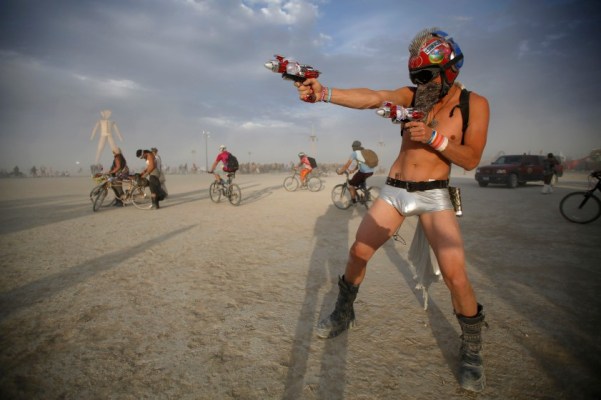Burning man is both an intrinsic part of Silicon Valley and a DJ party in the desert. It’s a place where folks are free to run around in sparkles and spandex and leather and nothing, covered in dust. A place for rich people to party and nude hippies to dance around the fire. But most of all it’s an experimental prototype for human technological possibility in the middle of nowhere that stands on the principle of radical acceptance of everyone.
It’s not easy to explain an entire city full of nearly 70,000 different people. But for the curious, allow me to try.
Baby’s First Burn
It’s nighttime when my driving buddy Ben Parr and I arrive in Black Rock City. It’s been a long 8-hour journey from San Francisco to Gerlach, with another 5 hours on top of that waiting in the long line to get in the gates. Someone in line ahead of us tells us this line is actually short. Greeters in long white robes welcome us “home” at the Burning Man gates and direct us to yet another long line of cars. We were the lucky few who escaped the storm that left thousands on the side of the road for 18 hours.
Already camp mates have been working hard to erect a giant shade structure, kitchen, water and power supplies when Ben drops me off at my camp around 10 pm. My camp, Ideate, is made up of carefully selected innovators, startup founders, VC’s and the tech reporters who cover them (Reporters from VentureBeat, Re/code, Fast Company and TechCrunch are all in this camp). As my tent mate, Shauna Causey, put it, “Ideate is full of founder do-gooder types.” Causey sold her last company Decide.com to eBay and has served as VP at Startup Weekend. Another camper, Doc North has his own tech show “In the Making” on the YouTube Discovery Channel network. Tim West, part of the camp leadership crew, is a former Facebook chef and co-created the Future of Food Hackathon.
“Is there room for me?” I ask, pointing to a spot at a table in camp next to an older gentleman. He welcomes me in and tells me his name is Raj Sandhu, a VC from San Francisco. He’s not in our camp but bought into the Hare Krishna vegan meal plan offered here.
Sandhu and I exchange the regular chit chat about our daily experiences around Black Rock City — the very tall man in the big combat boots dancing in front of a giant purple penis structure, our favorite art cars – mine is the golden dragon Viking ship, the monkey chanting workshop, whether we’ve gone inside the Orgy Dome or not (there’s an orgy dome and it is what you think it is). It’s both of our first time here. Neither of us can help but notice how intrinsically intertwined tech is to the art and experience of this event.
“Go out into deep playa,” Sandhu tells me, “you’ll see this structure that can be manipulated with an iPhone.” Deep playa sits way out in the distance of Black Rock City, about a couple miles from where everyone’s set up camp. Large art structures, several with LED lights, digital displays and other technical work pop up out of this dusty wasteland in every direction.
The desert festival has a rep as something for dirty hippies on drugs. It’s a surprise to hear of the Silicon Valley element in the last few years. Now mentions of technorati on the playa seems so commonplace it’s hardly worth talking about.
Google’s Larry Page and Sergey Brin have been coming to Burning Man consistently for well over a decade. The first Google doodle was an homage to The Man. Amazon’s Jeff Bezos and Mark Zuckerberg have made the trek. Drew Houston, co-founder of Dropbox camped out this year and Alexis Ohanian from Reddit was there as well.
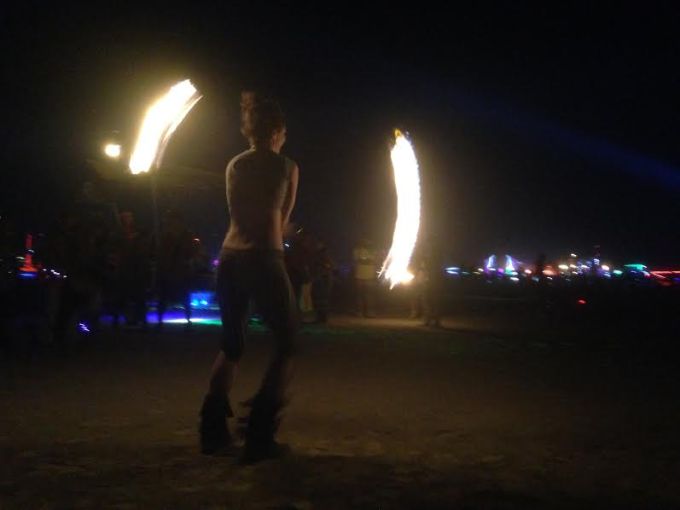
Fire Dancer performs out on the playa at Black Rock City.
Still, other tech leaders chose to stay away this time around. We were told by Elon Musk‘s people that the tech titan didn’t go this year, though they declined to comment as to why. Musk, notably, came up with the idea for SolarCity while at Burning Man a few years back, then gave the concept to his cousins.
Box co-founder Aaron Levie joked on Twitter that he was ahead of the curve for not going.
Attendance was down overall this year by a few thousand people, according to the latest 2014 Burning Man Census Report. Those numbers are from a census insider and not officially published yet.
Friday’s official peak attendance was at 65,922, below the Bureau of Land Management cap of 68,000 and the projected 70,000 attendance for this year. It should also be noted that BMIR, the official radio station of Black Rock City, reported that 10,000 people had already left the city before the man burned.
Part of this non-attendance could have been because of the earlier rain fiasco or the rumors that Burning Man had been canceled. And perhaps part of the early exodus had to do with Jack U’s (aka Diplo and Skrillex) poor choices during a set at Robot Heart.
While a lot of people ask which famous people came, that’s not the focus for everyone. I’m chatting about who’s who with my tent mates when a guy comes in and sits down in our tent and then screams that he doesn’t care who anybody is and can I please put down my phone and turn off my walkie talkie.
It’s funny to me because I get where he is coming from. As a counselor at Camp Grounded, a summer camp where adults go to purposely unplug, it makes sense that my use of tech while camping would annoy him. But I kind of need these tools. Or I think I do. I’m here on assignment as a reporter. I need a way to communicate with the outside world in some way. Does this change my “burn”? Is unplugging part of it?
Others just accept tech as part of the overall experience. “Burning Man is tech,” a woman named Wolf tells me as we wait in line for the Dr. Bronner’s foam party – a much-lauded naked group shower experience at Burning Man for the past several years.
Wolf, a tech entrepreneur-turned-fire-dancer, has been coming to Black Rock City since 2005. “But don’t the tech elites ruin the burn for others?” I ask her. Wolf pauses, pulls out a pasty zinc sunscreen and plasters her lips in white before thoughtfully replying.
“Look, the spirit of Burning Man is innovation. We wouldn’t have any of this without tech. It started with people in San Francisco and that’s what brings all this out here. And besides,” she says, rolling her eyes, “Larry Harvey’s camp is the original plug n’ play.”
Plug n’ play refers to camps that have everything set up for you before you arrive, right down to chefs making your food and your living space already arranged.
I talk about startups a lot, but usually not naked. Yet here I am discussing Facebook, Google and the latest startpus while waiting to get blasted by Dr. Bronners soap foam in a giant box with 50 other dusty weirdos. It’s the perfect collision of Silicon Valley and Burning Man. It’s all part of that spirit of challenging the status quo, innovation and self-reliance that embodies startup culture.
Larry Harver, Original Burnster
Burning Man started with a bad breakup. Founder Larry Harvey built a small structure resembling a man and burned it on Baker Beach in San Francisco 28 years ago. It was a symbolic gesture to help him get over the heartache and symbolically burn away his old self. The festival has since moved to the Nevada desert and has grown to an attendance of nearly 70,000 people annually.
Life on K Street
It doesn’t seem like the tech elites are ruining it for burners as much as the so-called “rich people camps.” Talk of their existence irks many burners this year. Still others share in the Burning Man principle of radical inclusion for all, rich or not. I put up a simple question on the Burning Man Facebook Group about whether the rich people camps affect the burn experience or not. It had 168 strongly worded opinions at last count.
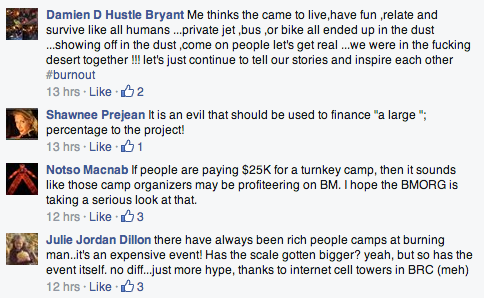
A bald man dripping with silver body paint who came to visit Ideate mentions one such camp to me, way out on the edge of town. He was a late addition to the camp he claims costs $25,000 or more for each member to join, though he was “gifted” his spot, “We get fresh sushi flown in every day and our own Segways,” he brags.
Curious, I wander over with my aforementioned tall, blond tent mate to see what this camp is all about. The camp is hard to find at first. A bartender/fruit smoothie maker at the camp in front of it pours a ginger carrot mixture into my cup. Her camp, Lost and Found Hotel, looks swanky enough. Each camp mate has individual canvas pods to sleep in and there’s a front desk check-in. She tells me it’s mostly made up of builders and artists in her camp. It’s nice, sure, but not a $25,000 glamp camp. Not anything like the camp we are about to see. She points the two of us to an ornate Middle Eastern looking structure hidden behind a bunch of semi trucks in the back. “Seriously, go take a look, you have to go see it,” she tells us.

I quickly find that, contrary to other reports, the camp is not a private, walled-in place only available to rich kids. We walk right in and are offered fresh fruit and beer. But it is definitely where the rich kids stay.
Plush couches and giant bean bags are placed about for anyone to lounge in. I ask a gal at the bar how much everyone paid to stay here. “Oh easily $25k,” she tells me. She is a member of the camp and not paid to bartend. Some of the camp members are entrepreneurs or in tech, she confirms. The vast majority of them are from the LA entertainment scene, though. She lets me know everyone here pitches in and takes shifts…but yes, they do have a kitchen staff hidden behind the camp, making meals for them every day.
The camp also comes complete with hotel-style walled-off glamp tents with coolers in them for each of the members. Causey and I peak inside to find fluffy pillows and white comforters await each guest. Segways are available to each member for easy use and many camp mates flew in on private jets – all part of the package. The main bar is lined with top shelf vodka. An ornate DJ stage hangs above. Causey asks for a drink at the bar from a petite woman wearing false eyelashes and a corset. She’s told that the “good stuff” is for camp members only.
Okay, so not everything is available to just anyone here. We are once again directed to the fresh fruit and beer. There was also free water, electrolytes and coffee in back.
“You know, it’s funny, these camps want to experience Burning Man but by coming in and having everything planned for them, they deny themselves the actual experience,” says an older gentleman who goes by David Magic Hands. He’s been coming to Burning Man with the HeeBeeGeeBee Camp for the last 16 years and runs a retreat devoted to female orgasm in Costa Rica. His orgasmic wisdom is his gift to the playa.
“What are these kinds of camps giving back?” David Magic Hands asks me.
People do as people do with their opinions about the “other.” Especially on social media. Bill Bo posted his experience with the so-called “rich people” on the same Burning Man Facebook group:
A fancy schmancy high end bus camper was headed down Darjeeling on Thursday morning as we were having our morning coffee on the crackly fresh playa lawn out front. The driver waved. I asked the universe for beer. He stopped, walked around to the supply bay, reached in there and got us a 30 pack of Miller High Life beer. We gave him one of our Burner shirts from the free box we had in front of our camp. I think we can all get along.
The Buck Starts Here
Rich camps seem relative in a place that, at minimum, costs the average attendee at least $1000 to go. The ticket just to get in is about $393.50 with tax, then there’s camp dues, food, water, camping supplies, costumes, travel. Over $56 million Burning Man dollars were pumped into Nevada last year, up nearly $11 million from the year before, according to event organizers.
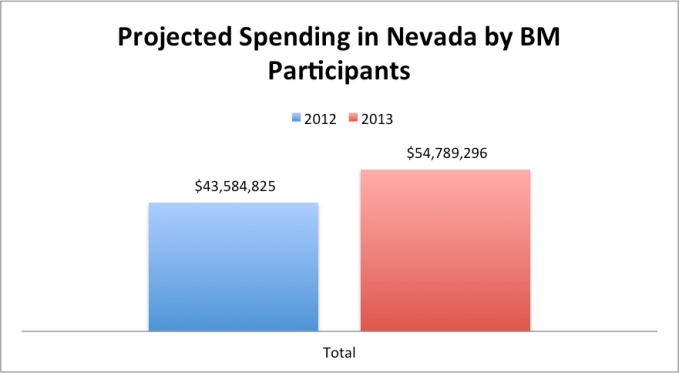
Of course $4.5 million of that goes to the Bureau of Land Management and another $10 million is estimated to be spent on airport travel. The average burner reported spending at least $250 in last minute camping supplies, food and water in Nevada, according to the 2012 Census.
Looking out from the middle of the playa one night near a ginormous LED-lined structure of the word “LOVE,” Ryan Parks, co-founder of Sacred Media, relays how important it is to him that tech leaders, rich people and others get this experience anyway, “This is the height of human luxury and I think most people would twist that to make that a bad thing, but this is a great experiment in self-actualization. You can see it when you look around at the amazing works of art that people are driving around. This is where we see human ingenuity and creativity at it’s finest,” says Parks.
“Silicon Valley is a lot like this,” he adds. “It’s the epicenter of the makers of the world. And the makers will remake the world in the digital age.”
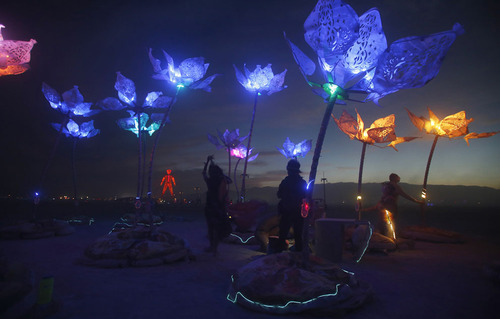
Credit: Jim Urquhart, Reuters
Whether it’s a sign of the times or the influx of more tech workers at Burning Man, this human ingenuity has brought with it some modernizations this year. There’s cell service now, BRC organizers have placed four cell towers for texting within the city. There are apps like “Time to Burn” and “iBurn” to help you schedule your favorite events. Facebook friends can find each other using the Facebook Burner Map app. Some camps offer wifi and one even has a solar powered steam room.
My own camp organized a speaker series. Giant Buddha statues greeted burners as they wandered into camp to hear about building cities of the future, robots and government.

Uhuru is another Burning Man camp made up of mainly San Francisco founders that broke off from Camp Ideate to create their own tech innovators group on the playa.
Dennis Kucinich showed up for his talk in a blue dress shirt and khakis – surely setting him apart amongst a crowd of spandex and sparkly things. Going by his playa name, “Charge,” Kucinich discussed privacy, government surveillance and marijuana legalization.
Libertarian-leaning Republican Grover Norquist, who came to Burning Man for the first time this year, was also scheduled to speak at Ideate, but rumor was he had to cancel his appearance because of threats.
While it seems there’s still some work to do on the radical inclusion front, just the fact that a man who once ran for president, a major political representatives and even a speaker series now at Burning Man is a bit of a jolt to me. This is not the Burning Man I had pictured, full of bad DJ’s and acid tripping hippies.
TEDx held its own series in the “spirit of ideas worth spreading.” There were Reddit meetups, bitcoin meetups, the FauxMirage camp, home of the Dr. Bronner’s foam party, held its own lecture series on cannabis and psychedelics as medicine. Did it bother people that Dr. Bronner’s was commercially mentioned?
Any type of branding is frowned upon here. Someone even asked me to cover the logo on my own drinking cup earlier. Dr. Bronner’s seems to get a pass, though. The camp doesn’t advertise itself as the name brand, but everyone knows it as such.
The half-naked guy in a pony tail at the front of the line corrects me when I ask about the Dr. Bronner’s camp. “I have no idea what you are talking about,” he says, then nods to the camp’s signage. “This is FauxMirage.” But everyone outside knows what it is.
Sacred Spaces
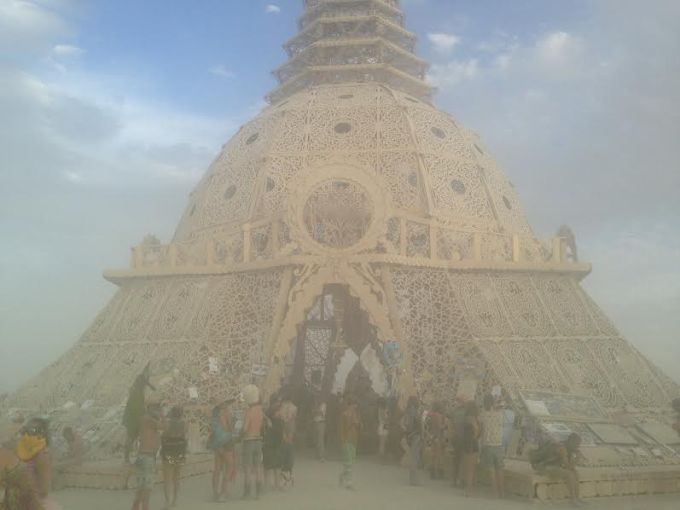
People who’ve been to Burning Man sometimes talk about the drugs, the parties, the music, and the tech elites at Burning Man. What they don’t really mention before you go is that there is Burning Man the festival and then there’s Burning Man the religious experience.
The beautiful, brain stimulating art, LED lights, costumes (or lack thereof), the mind-numbing throb of constant music and drum beats pulsing through your entire body, the openness, the love, the incessant hugging and the lack of a true night’s sleep all combine to bring about this wildish mental state observable in even the most curmudgeonly soul.
You breathe all of that in and carry it to the temple structure way out past The Man, then, when you get there start reading messages scrawled about the intricate wood work structure about regrets, sanity, suicide attempts or loved ones who’ve died. You might just lose it right there. Many do. You can hear the sobs among the quiet reverence within the wood cut walls.
I almost lost it here, too but didn’t. That would come later.
I did take some time to reflect on my younger brother, killed in a hiking accident 11 years ago. I thought about his soul and mine and I felt a reverence in that moment. One single tear ran down my dusty cheek and then I was done.
Crying at Weddings, the Burner Way
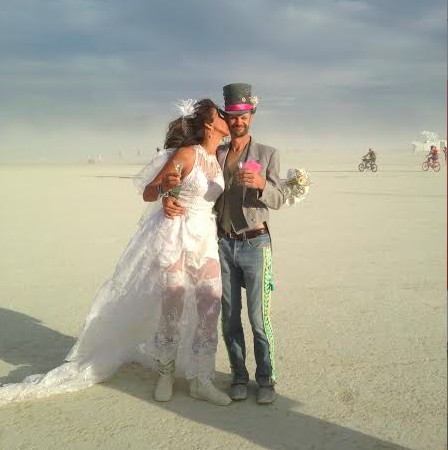
There’s a lot of weddings, engagements and commitment ceremonies to crash at Burning Man. So many folks get married at dawn or sunset at the Temple they have to choose different areas on the outside for their individual events. Photographers and onlookers line up to see the bride and groom or groom and groom or bride and bride…or just the bride. The famous-for-being-tech-famous Julia Allison married herself this year.
I crashed an engagement ceremony of one of the Ideate founders. About a hundred of us sat on the dirt carpet, dressed in our finest feathers and leather and lace and whatever else we felt like while the groom and his bride-to-be relayed their engagement story. Both his parents and a new age priest stood by their side to support them.
They were standing in a rushing river, buck naked, wild horses running in the background, as he knelt down on one knee and asked her to be his forever. This was so Burning Man.
It made me pause. People actually live this way in a weird, wonderful hippie fairy tale, surrounded by a loving community of family and friends. Perhaps it was the lack of sleep or that my mind had been overstimulated for the last 5 days straight, but it was there that I broke down and actually, embarrassingly, bawled my eyes out in front of a hundred or so people. This universe existed and it was wonderful and I wanted to be a part of it.
Burning Man changes you.
Black Rock City, USA
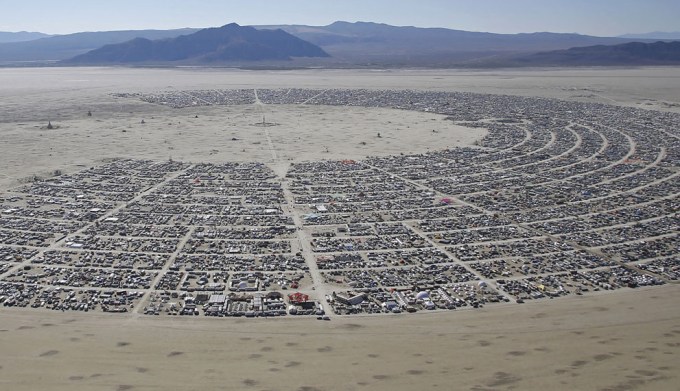
Black Rock City is neatly laid out neatly in a half disc with roads marked in time like 2:00, 2:30, 3:00 and so on until you get to 10:00. It criss-crosses alphabetical intersections from Antioch to K. You say “Meet up at Darjeeling and 9:00” as the address.
The pop-up city boasts two public libraries (yes, you can actually check out books during your time on the playa), a media center, police station, bars, clubs, pop-up restaurants serving poutine and grilled cheese sandwiches and even a makeshift medical unit complete with high-tech X-ray machines to check for broken bones and other maladies. It’s a truly free form of healthcare, paid for by your Burning Man ticket.
“Making things is critical to innovation,” says Debra Costa, CIO for the city of San Leandro. She’s referring to the creation and innovation created in the temporary city that is Burning Man. Costa came to Black Rock City for the first time this year to study the kinds of innovation and rapid prototyping that happens on the playa. She told me she hopes to bring that same bit of magical thinking back to her own town.
“San Leandro is a lab city,” she says. “If we are going to innovate we have to learn to do it on the fly, just like at Burning Man.”
Costa and her colleague Michael Caplan, Berekley’s economic development manager and a burner since 1998, agree with Tesla and SpaceX founder Elon Musk when he said “Burning Man is Silicon Valley.” As Caplan put it to me, “[Elon’s] idea for the Hyperloop from San Francisco to L.A. is a paradigm shift.”
“What Elon was referring to is every region has a different genomic footprint.” says Greg Horowitt, a first time burner and a Silicon Valley VC. “There is a religion, a social contract in play here. You come into Burning Man knowing that your values align with the values of the people here and it’s all about creation and experimentation,” he says.
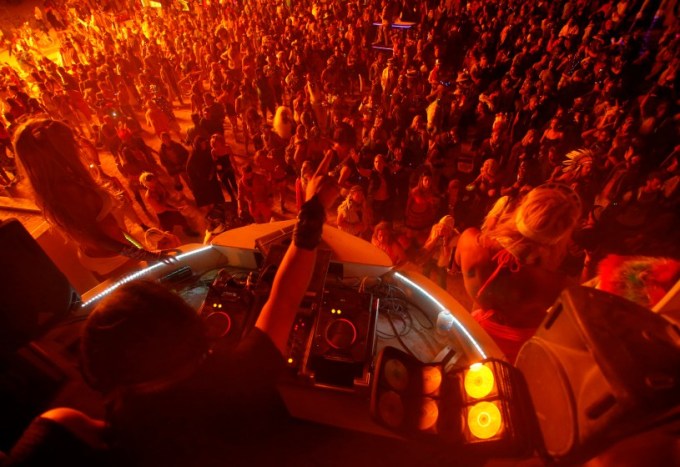
Credit: Jim Urquhart, Reuters
Musk derided Mike Judge’s HBO show Silicon Valley for not getting the real Silicon Valley because, according to him, Judge had never been to Burning Man.
“If you haven’t been, you just don’t get it.” said Musk. “You could take the craziest L.A. party and multiply it by a thousand, and it doesn’t even get fucking close to what’s in Silicon Valley.”
Silicon Valley certainly has a strong connection to the Burning Man culture. The event started in SF. Its headquarters are in the downtown area of the city and burner parties (also known as decompression parties) are held throughout the year in San Francisco. But there’s an understanding of this culture before and after Burning Man.
For those who haven’t been before, the word “burner” has a certain connotation. To those who have, “burner” encapsulates a greater hope for the human race. It’s much easier to see how the Burning Man principles of radical self-expression, radical self-reliance and civic responsibility are woven into the fabric and even influence startup culture in the Valley. But I only got that after I experienced it for myself.
Both Black Rock City and Silicon Valley embody a similar cultural ethos — the encouragement of rapid prototyping, a disregard for the status quo and how things have been done before, and the self-reliance to change the world around you for the better.
On the less positive side, startups and camps are both pushing to make a name for themselves. In just the last few years, camps have started to identify with laser or wood cut necklaces to signify membership. One of the art cars, the Christina, a yacht-looking vehicle, reportedly denied several people access to board because they weren’t wearing the proper wristband. Burning Man says it’s not about brands, but in a sense it is. Well-known musicians Skrillex and Major Lazer perform at certain sound camps and everyone knows FauxMirage as the Dr. Bronner’s camp. While that’s not the official name, it’s great branding.
Still, Silicon Valley could learn more about altruism and building for the sake of improving the world for others. We’re already starting to see that with more non-profit or for-good startups like Yerdle or Immunity Project. Attending Burning Man could help Silicon Valley avoid building jerktech and use the potential of human creation for the advancement of all, not just a few.
Musk is right in a sense, Burning Man is Silicon Valley, or at least a microcosm of it, with the potential to influence much more of it. And if you haven’t been you just don’t get it.
